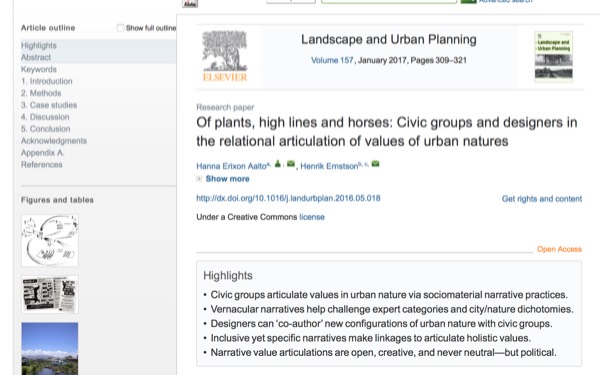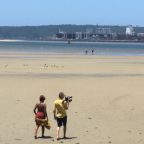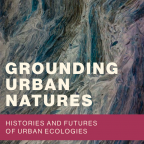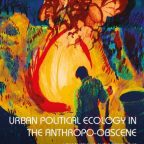How are values of contested urban green spaces articulated across cultural contexts such as Cape Town, New York and London? What is the relation between civics and urban designers in value articulation? A new Open Access article has just been published in Landscape and Urban Planning by KTH’s landscape architect Hanna Erixon Aalto and political ecologist Henrik Ernstson dealing with these questions.

Value articulation as sociomaterial narrative practice
Based on empirical work in Cape Town, New York and London the article expands on an existing narrative framework for value articulation (see Ernstson 2013; Ernstson and Sörlin, 2009; Sörlin 1998). Above all they emphasise the sociomateiral character of narrative practice and the role role of designers:
[T]his framework pays attention to how professionals such as artists, scientists, designers and journalists knowingly or unknowingly provide artifacts that can be used selectively by others. Artifacts function as mediators which, being material and movable, can connect social arenas and help bring constituencies together. Value must here be seen as performative and as emerging from narrative. (Erixon Aalto and Ernstson, 2017, p. 311)
And they continue by clarifying how values can never be atomistic or essential, but emerge out of story-telling and a relational symbolic context:
Mattingly (1998; drawing on Ricoeur, 1984) views narrative as a fundamental human activity that connects motives, acts, and consequences to build causal chains to explain what is of value in political and moral terms. On a fundamental level, storytelling is a tool to bring forth memories and experiences in order “to understand and critique [social and political] contexts” (Alsaker & Josephsson, 2011, p. 55). Values thus need a symbolic context in order to make sense; they are not atomistic, nor derived from intrinsic or essentialist properties but emerge from acts of story- telling where things, events and places are placed in relation to each other (see e.g. Cameron, 2012; Ernstson, 2013b; Hajer, 1995). (Erixon Aalto and Ernstson, 2017, p. 311)
Expanding use of narrative theory: design professions, imagination and materiality
The paper uses this framework to address three interventions into urban green spaces—the wetland Princess Vlei in Cape Town, the post-industrial site of The High Line in New York, and a park outside London in Essex. The work expands narrative theory in several directions:
- To better understand how urban design professions are part of narrative practices;
- To understand the imaginative powers of story-telling, i.e. to be able to change how a particular place is perceived and what could come to happen there; in cultural and narrative theory this has been referred to as the “subjunctive” or “what if” mode, or as phrased by Castoriadis as “the capacity to posit that which is not, to see in something that which is not there”’ (Castoriadis, 1997, p. 151).
- To better foreground the sociomaterial aspects of value articulation and narrative practice, i.e. “how materials and materiality participate in collective action and social life” (developed from Ernstson 2013a, 2013b)
As they illustrate in their analysis, landscape ‘objects’ are engaged through their own materiality, “not in any determinate form, but as participants—[and] influence how people and things are brought together (Latour, 2005), what acts of storytelling can be done, and how people and authorities come to (re-)think the meaning of these landscapes (Law, 2009).” They summarise their theoretical viewpoint:
Taken together, we view value articulation as a relational and sociomaterial accomplishment that aligns human and non-human actors, including artifacts and social arenas, to assemble a narrative. This narrative in turn works to legitimize and make claims about what is of value, often in contestation to other values and uses (Ernstson, 2013a, 2013b; Fig. 1).
An anti-essentialist “bottom up” approach to understand value
They conclude that their case study analyses across Cape Town, New York and London demonstrate the ability of narrative to weave together actors, artifacts, and arenas, and to tell stories through which values are articulated and, in public discourse, de facto created. They emphasise that such “bottom-up analysis” of how values emerge can be viewed as as complementary, or in conflict with, analytic approaches that start from expert evaluation, or that is insensitive to localised practices, histories and cultures, as for instance the ecosystem services framework have been critiqued to be (see Ernstson & Sörlin, 2013).
This mode of analysis helps to dislodge singular, essentialist, and universalist ideas of nature, and instead emphasizes that “multiple natures are locally embedded in historically specific social practices” (Lachmund, 2013, p. 237). We believe that this can help to profoundly rethink policy, planning, and practice in terms of: (i) how urban nature can be re-humanized and historicized by being embedded in vernacular stories about the city; (ii) how expert cat- egorizations, such as city versus nature, can be undermined; and (iii) how various skills and ways of knowing can be brought into planning processes.
Download the Open Access article here at Landscape and Urban Planning. For other articles mentioned, see Henrik Ernstson’s academia.edu page for further links.
References
Erixon Aalto, H and Ernstson, H, 2017, “Of Plants, High Lines and Horses: Civics and designers in the relational articulation of values of urban natures” Landscape and Urban Planning 157 309–321, http://dx.doi.org/10.1016/j.landurbplan.2016.05.018.
Ernstson, H and Sörlin, S, 2013, “Ecosystem services as technology of globalization: On articulating values in urban nature” Ecological Economics 86 274–284, http://linkinghub.elsevier.com/retrieve/pii/S0921800912003746.
Ernstson, H and Sörlin, S, 2009, “Weaving protective stories: connective practices to articulate holistic values in the Stockholm National Urban Park” Environment and Planning A 41(6) 1460–1479, http://www.envplan.com/abstract.cgi?id=a40349.
Ernstson, H, 2013, “The social production of ecosystem services: A framework for studying environmental justice and ecological complexity in urbanized landscapes” Landscape and Urban Planning 109(1) 7–17, http://linkinghub.elsevier.com/retrieve/pii/S0169204612002861.
Ernstson, H, 2013, “Re-translating nature in post-apartheid Cape Town: The material semiotics of people and plants at Bottom Road”, in Actor-Network Theory for Development: Working Paper Series Ed R Heeks (Institute for Development Policy and Management, SED, University of Manchester, Manchester), p Paper 4/2013, http://www.cdi.manchester.ac.uk/resources/ant4d-working-papers/.


